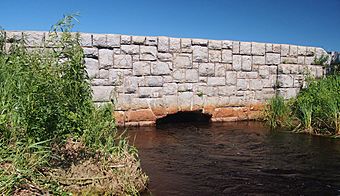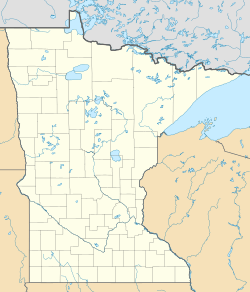St. Alban's Bay Culvert facts for kids
Quick facts for kids |
|
|
St. Alban's Bay Culvert at Mille Lacs Lake
|
|

The St. Alban's Bay Culvert from the southeast
|
|
| Location | |
|---|---|
| Area | Less than one acre |
| Built | 1938–9 |
| Built by | Civilian Conservation Corps, Minnesota Department of Highways |
| Architect | Howard O. Skooglun (architect), Harold E. Olson (engineer), Arthur R. Nichols (landscape architect) |
| Architectural style | National Park Service rustic |
| MPS | Federal Relief Construction in Minnesota, 1933-1941 |
| NRHP reference No. | 15000788 |
| Designated | November 16, 2015 |
The St. Alban's Bay Culvert is a special old bridge in Garrison Township, Minnesota. It helps U.S. Route 169 cross a small stream. This stream flows from Mille Lacs Lake. The bridge was built between 1938 and 1939. It was part of a big project to make a beautiful road along the lake.
This bridge is important because of its design and how it was built. It shows early efforts by the Minnesota Highway Department to make roadsides pretty. It also has a cool style called National Park Service rustic. The bridge was added to the National Register of Historic Places in 2015.
Contents
What Does the St. Alban's Bay Culvert Look Like?
The St. Alban's Bay Culvert is a concrete bridge. It has long stone walls at each end. These walls are made of local granite. They are about 9 inches (23 cm) thick. The stone covers a core of lake boulders.
The walls rise about 2 feet 9 inches (84 cm) above the road. They form a low railing. At both ends of the bridge, there are extra stone panels. These panels add to the bridge's cool look. The opening under the bridge is shaped like a wide arch. It is about 6 feet (1.8 m) tall.
The bridge is about 72 feet 6 inches (22.1 m) wide. The road part is about 66 feet (20 m) wide. Over the years, new layers of road have covered the original stone curbs.
How Was the St. Alban's Bay Culvert Built?
The St. Alban's Bay Culvert was part of a big plan. This plan was called the Mille Lacs Lake Highway Improvement Plan. It was a project from the New Deal era. The New Deal was a series of programs in the United States. They helped people get jobs during the Great Depression.
The goal was to turn the road around Mille Lacs Lake into a scenic parkway. This means a road designed to be beautiful. Many groups worked together on this project. These included the Minnesota Highway Department (MHD) and the National Park Service (NPS). The Civilian Conservation Corps (CCC) also helped a lot.
Who Built the Bridge?
The CCC was a program that gave jobs to young men. They worked on conservation projects. Company 2711 of the CCC did most of the work. Their camp was near Garrison, Minnesota.
The project made the highway wider. It went from two lanes to four lanes for 10 miles (16 km). They also built three rest areas and four stone bridges. The St. Alban's Bay Culvert was one of these bridges.
Who Designed the St. Alban's Bay Culvert?
Howard O. Skooglun designed the bridge. He was an architect for the National Park Service. He worked with Harold E. Olson, an engineer. Arthur R. Nichols was a landscape architect. Both Olson and Nichols worked for the Minnesota Highway Department.
This team also designed other parts of the scenic parkway. These include the Garrison Concourse and the Kenney Lake Overlook. They also designed Bridge 5265 and Bridge 3355. These other structures are also on the National Register of Historic Places.
When Was the Bridge Completed?
Work on the St. Alban's Bay Culvert started around September 1938. They made an older bridge wider. The old bridge was built in 1920. It went from 39 feet 6 inches (12.04 m) wide to 72 feet 6 inches (22.1 m) wide. This made room for the new lanes. The bridge was finished in the spring of 1939. That summer, another CCC company helped with landscaping around the bridge.



